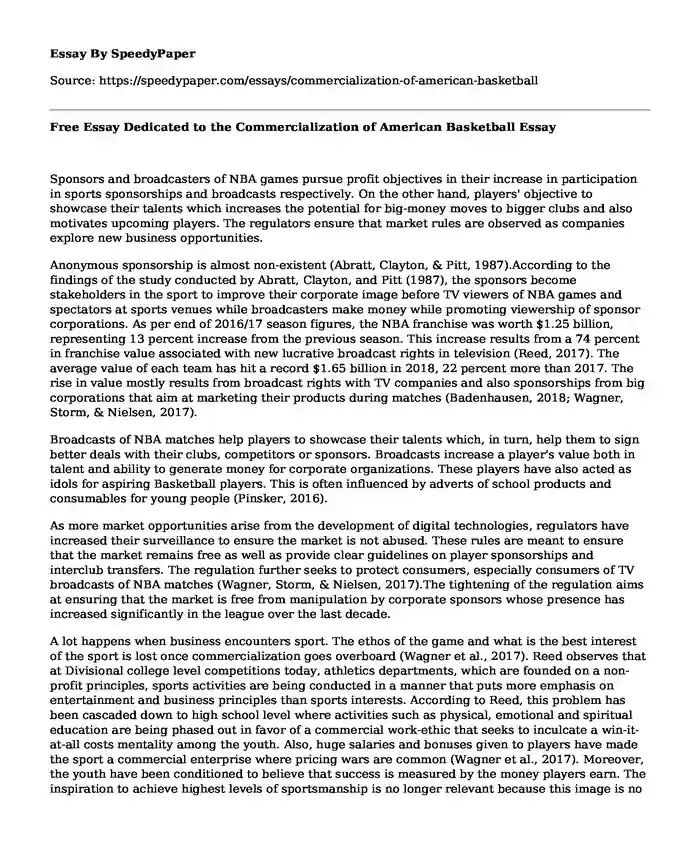Sponsors and broadcasters of NBA games pursue profit objectives in their increase in participation in sports sponsorships and broadcasts respectively. On the other hand, players' objective to showcase their talents which increases the potential for big-money moves to bigger clubs and also motivates upcoming players. The regulators ensure that market rules are observed as companies explore new business opportunities.
Anonymous sponsorship is almost non-existent (Abratt, Clayton, & Pitt, 1987).According to the findings of the study conducted by Abratt, Clayton, and Pitt (1987), the sponsors become stakeholders in the sport to improve their corporate image before TV viewers of NBA games and spectators at sports venues while broadcasters make money while promoting viewership of sponsor corporations. As per end of 2016/17 season figures, the NBA franchise was worth $1.25 billion, representing 13 percent increase from the previous season. This increase results from a 74 percent in franchise value associated with new lucrative broadcast rights in television (Reed, 2017). The average value of each team has hit a record $1.65 billion in 2018, 22 percent more than 2017. The rise in value mostly results from broadcast rights with TV companies and also sponsorships from big corporations that aim at marketing their products during matches (Badenhausen, 2018; Wagner, Storm, & Nielsen, 2017).
Broadcasts of NBA matches help players to showcase their talents which, in turn, help them to sign better deals with their clubs, competitors or sponsors. Broadcasts increase a player's value both in talent and ability to generate money for corporate organizations. These players have also acted as idols for aspiring Basketball players. This is often influenced by adverts of school products and consumables for young people (Pinsker, 2016).
As more market opportunities arise from the development of digital technologies, regulators have increased their surveillance to ensure the market is not abused. These rules are meant to ensure that the market remains free as well as provide clear guidelines on player sponsorships and interclub transfers. The regulation further seeks to protect consumers, especially consumers of TV broadcasts of NBA matches (Wagner, Storm, & Nielsen, 2017).The tightening of the regulation aims at ensuring that the market is free from manipulation by corporate sponsors whose presence has increased significantly in the league over the last decade.
A lot happens when business encounters sport. The ethos of the game and what is the best interest of the sport is lost once commercialization goes overboard (Wagner et al., 2017). Reed observes that at Divisional college level competitions today, athletics departments, which are founded on a non-profit principles, sports activities are being conducted in a manner that puts more emphasis on entertainment and business principles than sports interests. According to Reed, this problem has been cascaded down to high school level where activities such as physical, emotional and spiritual education are being phased out in favor of a commercial work-ethic that seeks to inculcate a win-it-at-all costs mentality among the youth. Also, huge salaries and bonuses given to players have made the sport a commercial enterprise where pricing wars are common (Wagner et al., 2017). Moreover, the youth have been conditioned to believe that success is measured by the money players earn. The inspiration to achieve highest levels of sportsmanship is no longer relevant because this image is no longer projected by successful NBA players (Reed, 2017). This has eroded the rationale of the sport.
A fundamental shift in the management of NBA clubs is the acceptance of commercial gains as the primary aim of running the clubs. Management decisions are based on profits to satisfy the interests of the investors and not entertainment. The overemphasis on profitability means clubs are required to innovate to generate more money, a management style that was a preserve for traditionally for-profit organizations. As a result, club fans are having little influence on governance (Wagner et al., 2017; Davis, 2015).
The need for innovation and sustained success at clubs has put pressure on club coaches and managers. They are required to deliver at all costs because that is the expectation of the new profit-oriented owners (Davis, 2015). This has made management of clubs a challenging profession in the modern times.
References
Abratt, R., Clayton, B. C., & Pitt, L. F. (1987). Corporate Objectives in Sports Sponsorship. International Journal of Advertising, 6(4), 299-312. doi:10.1080/02650487.1987.11107030
Badenhausen, K. (2018, February 7). NBA team values 2018: Every club now worth at least $1 Billion. Forbes.
Davis, T. (2015, October 22). On the ever-changing face of NBA ownership. Retrieved from https://www.si.com/thecauldron/2015/10/22/new-money-new-problems-changing-face-nba-ownership
Pinsker, J. (2016, June 13). Is there room for sports to get even more commercialized? The Atlantic.
Reed, K. (2017, May 21). Commercialization abuses tainting sports. The Huffington Post [New York].
Cite this page
Free Essay Dedicated to the Commercialization of American Basketball. (2022, Mar 21). Retrieved from https://speedypaper.com/essays/commercialization-of-american-basketball
Request Removal
If you are the original author of this essay and no longer wish to have it published on the SpeedyPaper website, please click below to request its removal:
- Literary Essay Sample - Raisin in the Sun: A Tale of Dreams
- Household Bleaches - Chemistry Essay Sample
- Free Essay Example on Truth in Art
- Essay Example on Corporate Social Responsibility (CSR) of Walmart
- Decriminalization of Marijuana, Free Essay for You
- Essay Sample on Data Processing Systems
- Essay Sample on Fascinating and Inspiring Aspects of Artificial Intelligence
Popular categories





